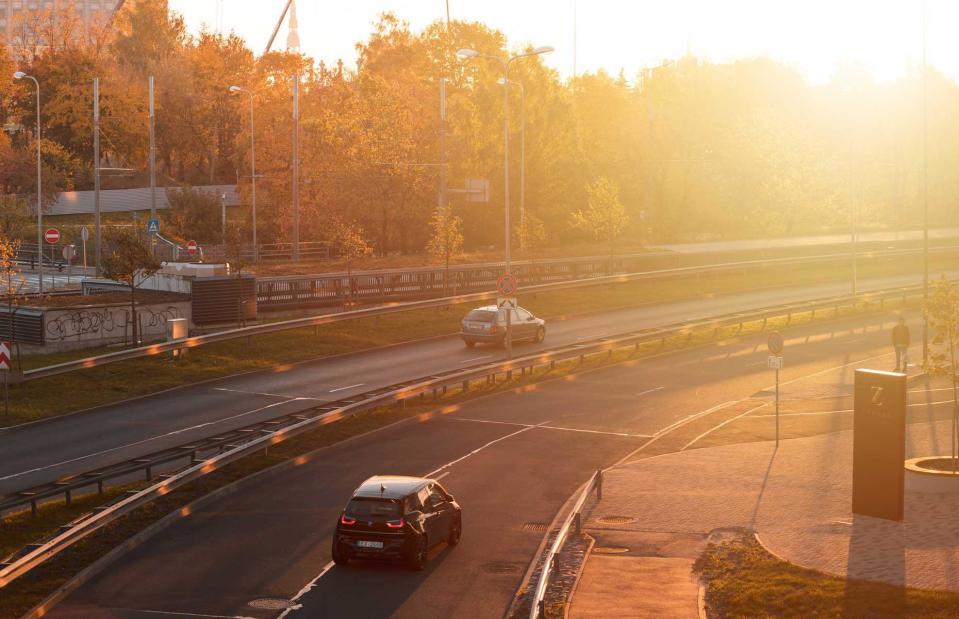Europe's most dangerous countries to drive in (and the safest): where the UK ranks
To drive or not to drive

ESB Professional/Shutterstock
Road trips can be a great way to explore Europe. But do you know which European nations are the safest – and most dangerous – to drive in? Based on a study by Vignetteswitzerland.com, which analysed the latest data from the European Transport Safety Council, we’ve listed the 10 safest European countries for drivers – and then the 10 most dangerous.
Read on to discover the European countries with the safest and most dangerous roads…
10th safest: Cyprus

FOTOGRIN/Shutterstock
Cyprus stands out as the 10th safest country in Europe for road safety, recording 34 road deaths in 2023 – equivalent to 36.9 deaths per million residents, given its small population of 920,701. With a road fatality rate 19% below the EU27 (European Union) average, this sun-soaked island punches above its weight in keeping drivers safe. So whether you're cruising along its scenic coastal roads or navigating its winding mountain routes, Cyprus is a relatively safe spot for drivers in Europe.
9th safest: Ireland

Benoit Daoust/Shutterstock
Ireland comes in ninth place for road safety, with 35.1 deaths per million inhabitants in 2023. A total of 185 people were reported killed in road collisions in Ireland last year, with a significant proportion of these deaths occurring during nighttime hours and weekends. To tackle rising road deaths, the Irish government introduced a new Road Traffic Bill in 2023. It includes reforms to penalty points, mandatory drug testing at serious collisions and revised speed limits. These measures support Ireland's goal to halve road fatalities by 2030.
8th safest: Germany

Frolova_Elena/Shutterstock
Germany saw 33.5 road deaths per million in 2023 – 26% below the EU27 average. Germany, which has a population of 84.3 million, is well-known for its automotive engineering and road infrastructure. The Autobahn system (pictured) is a world-renowned, 8,000-mile (13,000km) highway network with sections that have no speed limits.
7th safest: Finland

ArtBBNV/Shutterstock
Despite Nordic weather throwing the occasional curveball, Finland is a pretty safe place to drive, and its roads are generally in good condition. According to the data, Finland recorded 32.7 deaths per million in 2023, with182 fatalities in road traffic accidents – a drop from 2022 (196) and 2021 (225). This is partly down to improvements to the country's highways and the implementation of Vision Zero – a multinational initiative aiming to eliminate serious road traffic accidents.
6th safest: Malta

Lukas Bischoff Photograph/Shutterstock
In 2023, Malta recorded just 16 road deaths, translating to 29.5 fatalities per million residents – an impressive 35% below the EU27 average. For a small and densely populated island with over 542,000 people, this low fatality rate highlights Malta’s success in keeping its roads safer than many of its European counterparts. Key to this achievement are the country's targeted road safety efforts, including stricter traffic law enforcement and ongoing public awareness campaigns.
5th safest: Switzerland

Nick Fox/Shutterstock
If you’re after a European road trip, Switzerland has perhaps the continent's most scenic mountain roads. This landlocked country of 8.8 million people has a high-quality road network, with plenty of tunnels and bridges criss-crossing its steep Alpine topography. It is also one of Europe's safest countries for drivers, with 26.8 road deaths per million inhabitants in 2023. Since 2021, drivers aged under 20 have been required to have a provisional licence for at least a year before obtaining their full licence.
4th safest: Denmark

Kenneth Bagge Jorgensen/Shutterstock
Denmark had 26.1 road deaths per million inhabitants in 2023 – a massive 43% below the EU27 average. Denmark has some good stats to back up its high rating: it boasts Europe's highest self-reported rate of seat belt wearing in the back seat, and its self-reported rate of talking on a mobile phone while driving is lower than the European average. On the other hand, it performs worse than the European average for self-reported speeding and helmet use among cyclists.
3rd safest: United Kingdom

ESB Professional/Shutterstock
The UK takes the bronze medal in the list of Europe’s safest roads, with 25.1 road deaths per million in 2023 – a total of 1,716 fatalities. In 2024, England’s government invested £38.3 million ($49m) to make 17 of the country's most high-risk roads safer. In Wales, motorists now have to limit their speed to 20 miles per hour (32km/h) in built-up areas, and many areas of London have introduced the same limit as a default. Scotland plans to follow suit and make the policy nationwide by 2025.
2nd safest: Sweden

Christian L Sweden/Shutterstock
Sweden's residents will be pleased to know their roads finished second safest in Europe. Sweden saw 21.8 road deaths per million inhabitants in 2023 – partly the result of a commitment to Vision Zero, a road safety initiative that Sweden has followed since 1997, and which other countries are now part of too. Based on the idea that road systems and their designers are more responsible for crashes than road users, it aims to eventually eliminate serious injuries and fatalities from traffic accidents.
1st safest: Norway

Giedrius Akelis/Shutterstock
Norway – a land of stunning fjord-side roads and picturesque mountain passes – is the safest European country to drive in. The country recorded just 20 deaths per million inhabitants in 2023, 56% below the EU27 average. Norway, which adopted its own version of Vision Zero in 1999, has an excellent road safety record and fatalities have steadily declined. The year 2020 marked an important milestone – its 93 fatalities marked the first year on record that fewer than 100 people died on the nation's roads.
10th most dangerous: Poland

monticello/Shutterstock
Poland ranks as the 10th most dangerous country to drive in Europe, with 1,893 road deaths in 2023. This equates to 51.5 fatalities per million residents, which is 13% higher than the EU27 average. Factors contributing to this higher fatality rate include speeding, poor road conditions in some areas and the need for stricter enforcement of traffic regulations. Despite efforts to improve road safety, Poland faces challenges in reducing accidents and fatalities on its roads.
9th most dangerous: Italy

Ron van der Stappen/Shutterstock
Number nine on the list of most dangerous European countries to drive in is Italy, with 52.4 deaths per million inhabitants in 2023. Italy's roads are often narrow, congested and in poor condition, while distraction, issues relating to right of way and speeding are the main causes of accidents, according to figures from the Automobile Club d'Italia.
8th most dangerous: Lithuania

DroneTop/Shutterstock
In 2023, Lithuania saw 60 road deaths, amounting to 56 fatalities per million residents, a concerning 23% above the EU average. Despite its relatively small population of 2.86 million, Lithuania's road safety record highlights significant challenges. Risky driving behaviours, including speeding, and less-than-ideal road conditions in some regions contribute to this elevated fatality rate. Although efforts have been made to improve traffic regulations, more aggressive measures are needed to curb these figures.
7th most dangerous: Greece

Roxana Bashyrova/Shutterstock
Greece has one of Europe’s worst road safety records, recording 59.6 deaths per million in 2023. Compared to the rest of Europe, the country has low-quality roads and a high density of motorcycles – many fatalities involve motorbike accidents on urban roads. Greece also has a low rate of self-reported seat belt wearing and a higher than average rate of self-reported drink driving. In 2021, the Greek government launched a road safety plan that aims to reduce deaths by 50% by 2030, including upgrades to infrastructure and giving urban areas a 19 miles per hour (30km/h) speed limit.
6th most dangerous: Portugal

FranciscoMarques/Shutterstock
Portugal also has a higher-than-average road fatality rate. Despite a relatively modest population of 9.9 million people, it saw 600 deaths on its roads – or 60.2 per million population – in 2023. According to the European Commission, Portugal’s roads are relatively low density and are of high quality – so infrastructure doesn't seem to be the problem.
5th most dangerous: Croatia

Ilija Ascic/Shutterstock
With 274 deaths from road traffic accidents in total in 2023 – or 71.2 per million inhabitants – Croatia is the fifth most dangerous European country to drive in. While those figures are well above the EU average, Croatia's number of fatalities has decreased at a higher-than-average rate over the last decade. According to the European Commission, accidents often take place on urban roads after dark, while seat belt use is not enforced effectively.
4th most dangerous: Latvia

Janis Baiks/Shutterstock
Despite recent improvements, Latvia’s roads are still among the most dangerous in Europe, with 75.4 fatalities per million, 66% above the EU27 average. These figures are partly explained by poor-quality roads and infrastructure, while cars tend to be significantly older than the EU average and motorcycle helmets are not always worn. The country also experiences cold and potentially hazardous weather in the winter, during which winter tyres are compulsory.
3rd most dangerous: Serbia

tismaja/Shutterstock
With 75.7 road deaths per million inhabitants, Serbia is Europe's third most dangerous country for drivers. Speeding is the most frequent cause of crashes according to the International Transport Forum, with drink driving and distraction are also issues. Road quality varies widely but it's generally worse in rural areas, especially after bad weather. The Western Balkans Road Summit has called for safer roads in Serbia via stricter speed controls, improving infrastructure and more.
2nd most dangerous: Romania

DaLiu/Shutterstock
Romania is the second most dangerous European country to drive in, with 1,545 fatalities in 2023 – or 81.1 per million inhabitants. The causes include speeding and poor road quality, while an inconsistent level of investment in infrastructure means conditions vary greatly. The country has one particularly well-known road – the Transfagarasan Highway (pictured), which hairpins up the Fagaras Mountains in Transylvania and is a major tourist attraction.
1st most dangerous: Bulgaria

Viktorio Marianov Nitov/Shutterstock
Bulgaria takes the top spot that no one wants – it's the most dangerous European country to drive in. The country recorded 526 road deaths in 2023, which translates to 81.6 fatalities per million residents, a staggering 79% higher than the EU27 average. Key contributors to these numbers are speeding, a low rate of seat belt use and drink driving. Bulgaria has a higher than average legal alcohol limit for drivers and its 87 miles per hour (140km/h) maximum speed on motorways is one of the highest limits in the EU.
Read on to see stunning images of the most dangerous roads on Earth


